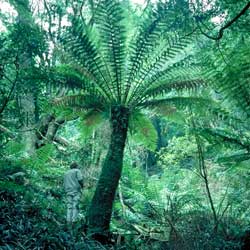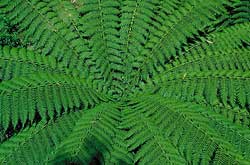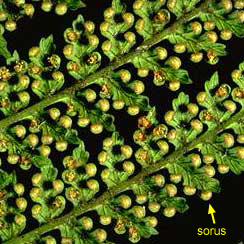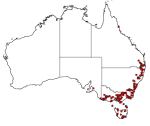Dicksonia antarctica
 |
 |
 |
Soft Tree Fern
Dicksonia antarctica is part of the family Dicksoniaceae. Members of this family are the tree ferns. They are terrestrial ferns and have an erect rhizome forming a trunk, large spreading fronds and are very hairy at the bas of the stipe. There are only one genera and three species in Australia with D. antarctica being the largest.
 D.
antarctica is wide-spread species growing from south-eastern Queensland,
through the NSW and Victoria coast and in Tasmania. This species is endemic
to Australia. In the wild this species likes to live in moist areas with high
water content in wet sclerophyll forests, along creek beds, in gullies and occasionally
at high altitudes in cloud forests.
D.
antarctica is wide-spread species growing from south-eastern Queensland,
through the NSW and Victoria coast and in Tasmania. This species is endemic
to Australia. In the wild this species likes to live in moist areas with high
water content in wet sclerophyll forests, along creek beds, in gullies and occasionally
at high altitudes in cloud forests.
D. antarctica is an attractive fern that can grow up to 15m in height; it has large dark green roughly textured fronds in a spreading canopy of up to 6m in diameter. A distinctive feature of this species is its small round sori (singular = sorus, a cluster of sporangia or spore capsules) only 1mm in diameter, with the other Australian species only growing to 4-5m and having sori of 2mm in diameter.
Propagation is primarily from spores but it can also be grown from plantlets occurring around the base of the rhizome.
It can also be grown as a ‘cutting’, a method not to be encouraged unless the tree-fern is doomed to die in its present position. This involves sawing the trunk through, usually at ground level, and removing the fronds; the top part will form roots and regrow, but the base will die. The ‘cutting’ should be placed in a cool position and regular overhead water applied. If this is done in August, new fronds will be produced during spring and summer and a mature plant will be obtained.(This method is not advised for Cyathea, the other tree-fern genus).
The condition D. antarctica thrives in is in filtered sunlight, loose well drained soils with lots of organic matter and lots of water. However, this species can still withstand some drying out and can survive in drier conditions.
D. antarctica is relatively easy to grow, the most important thing is to keep it moist and the base covered with mulch to keep it moist and supplied with nutrients. It is a valuable species in the garden as it can be used as a host for epiphyte ferns, orchids and bryophytes. It also provides shelter for more delicate fern species to flourish underneath. Other benefits of this species is that the mature specimens can be easily transplanted and it can be grown both in and out of doors.
Also, it can be used as a food source with the pith of the plant being eaten either cooked or raw and is a very good source of starch.
Text by Molly Hicks (Botanical Intern 2003)
Derivation of botanical name: Dicksonia antarcticaDicksonia - named in honour of James Dickson, 1738-1822, a Scottish nurseryman. antarctica - 'southern', or from the Antarctic regions. |
References:
C.H. Chaffey’s Australian Ferns – growing them successfully
Flora Australia volume 48
Wrigley, J.W. and Fagg, M. (1996) Australian Native Plants 4th ed, New Holland - Reed Publishers, Sydney.
![An Australian Government Initiative [logo]](/images/austgovt_brown_90px.gif)

